When adopting internationally, almost every waiting parent worries, “How will I communicate with my new child?” Whether your new child is a year old or thirteen years old, if your child was not born in an English-speaking country, there will be some type of language barrier. This is even more true if you are adopting a child with a special need related to communication – hearing loss, autism, Down syndrome, etc.
Finding a way to have meaningful communication is essential during the early days post-adoption, as your new child will need a way to express fear, anxiety, hunger, pain, illness and any number of emotions. And you will need a way to communicate to your new child that he or she is safe and loved.
So how can the communication gap be overcome when you speak English and your new child’s first language is Mandarin, Cantonese, or another dialect in which you are not fluent? What if your child isn’t able to hear your words at all (undiagnosed hearing loss happens in adoption more than one would expect)? While many new parents attempt to learn some simple phrases in the child’s native language (which is a fantastic), American Sign Language – or your country’s native signed language – can help open the door for communication between you and your child.

Benefits of sign language for a hearing child
“Why on earth would I teach my child sign language? My child can hear! Won’t that delay English learning and development?”
These questions indicate a very common misconception about sign language. The truth is, your child (and you) are already using a form of signed language from the very start. Pointing to show your child where to go, a child lifting his or her arms to be picked up, waving hi and bye, the potty dance… all of these are forms of nonverbal communication. Non-verbal communication is a very important first step in developing language for an infant or young child.
In the weeks post-adoption, especially when you are still in country, your child will be experiencing many changes and transitions, which can be very scary. You smell strange, sound strange, look strange – nothing about you is familiar to your new child. Your language is one that is likely being heard by your child for the first time, and the unfamiliar sounds can be difficult to understand. Even if you learn phrases in Mandarin or Cantonese, chances are those words are not going to sound the same to your child with the accent you are almost certain to have.
Sign language provides a common language that you both can understand.
A child who knows how to sign “eat” is less likely to scream and cry when hungry, which is a very common occurrence with a newly adopted child. Teaching your child the sign for eat and using it every time you feed your child can also provide a source of comfort for a child with food insecurity – imagine how comforted your child would be if he or she started crying and you signed “eat”? For perhaps the first time in his or her life, there would be reassurance that the cry was being answered immediately!
Dr. Claire Vallotton, from Michigan State University, emphasized the importance of signing with hearing infants by demonstrating that signing helps children develop more advanced spoken language at much younger ages. In fact, she cites research showing that between two groups of children, one that was taught sign during infancy and one that wasn’t, the group that knew sign was able to understand more words at 15 months of age, and produced longer sentences using more complex vocabulary at two years of age than did the group that did not know sign.
For children that came from an orphanage or experienced language deprivation, signing can help to give the child a way to begin to catch up to English-speaking peers.
Dr. Vallotton reported that there were fewer tantrums in children that knew sign, and that parental stress and frustration were reduced because the children that signed had non-verbal ways to communicate when and why they were upset. This is a clear benefit for children coming from traumatic backgrounds and who need to find the words to express fear, anxiety, sadness, and other post-adoption emotions.

Benefits of sign language for a deaf child
Obviously, the benefit of signing for a deaf child is clear – sign language gives a deaf child access to communication with those around him or her. For a deaf child from an orphanage, especially if the hearing loss was undiagnosed (as with my own son), a parent signing might be the absolute first exposure to being communicated with. Deaf children living in orphanages are at extremely high risk for language deprivation, usually either because the hearing loss is undiagnosed or because there was no exposure to Chinese Sign Language in the orphanage.
Language deprivation can lead to several significant emotional, cognitive, and mental health issues. But the good news is that sign language can help overcome these! A visual language is the natural language for a deaf child, so it is highly likely that your child will pick up on sign language very quickly.
My three year old son has now been home for a year (his family day was just a few days ago). He knows well over 200 signs, some colors, most of the alphabet, and can sign three to four word sentences. His favorite sign is “Want more yogurt please!”, along with “Shoes on. Play outside please!” He also attends a school for the Deaf with all instruction given in ASL, and he is able to keep up in class. Remember, he turned three on his adoption day and has only been exposed to language for twelve months – that is some significant progress in language development!
Benefits of sign language for a child with other special needs
Sign language can also be helpful for special needs that don’t involve hearing loss, including autism, selective mutism, Down syndrome, communication disorders, and cerebral palsy. In fact, many speech and language pathologists, autism specialists, and special education teachers are using sign language either as a first step for teaching spoken language to children with special needs, or as a primary and easily accessible language for those who may have difficulty developing spoken language.
Sign language has even been proven effective in children who have cerebral palsy and other disorders that make movement difficult, as signing can be adapted to many different skill and ability levels, as well as to individuals who are missing a hand or those who are visually impaired.
With more children being adopted from special needs programs and with the average age of children being adopted increasing, it is essential that parents find accessible ways to communicate with their children, especially during the early days post-adoption.
Sign language can help cross multiple barriers, including language barriers and those that come with a disability or special need.
Signing can also be a way to get your current children involved in the adoption and bonding process, as they learn and begin communicating with their new sibling. You don’t have to be fluent to sign – with video series like Signing Time! geared towards teaching sign language to hearing children and their parents, everyone is engaged and learning is fun for kids (and adults) of all ages.

Allison is the proud mother of four children, including one from Vietnam and one from China.
She is an autism behavior specialist, a religious education director with a focus on special needs catechesis, and a church sign language choir director. She also trains Catholic educators on making churches and classrooms welcoming to children and adults with disabilities.

























We used basic sign language with our son in addition to learning 20-30 useful phrases in Mandarin. He had just turned two when we met him, so having immediate communication was helpful, particularly with basic care like eating, drinking, bathroom/diapering needs, bath, hand-holding, etc.
I definitely recommend it also.
Do you mind sharing what resources you used to learn both Mandarin and sign language?
Just FYI American Sign Language is different from Chinese sign language for those who are adopting children from China.
We used sign language with our 2 year old daughter. It alleviated so much frustration with communication . Also, she picked it up very quickly. As a bonus, our older kids really enjoyed learning new signs and teaching them to her. There are many apps which show common signs. These were great resources. I highly recommend signing to anyone adopting. It was such a blessing for us. My daughter now almost 6 remembers a few signs too.
I forgot to mention that our daughter is cleft affected and had no language when we met her but desperately wanted to communicate.
So helpful!
Love this article. I am mom of 4 adopted boys, writing book series teaching sign language (first one will be released by Royal Fireworks Press Spring 2017. Inspired by the nonverbal students I worked with. Learnhandtalk.com